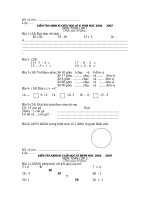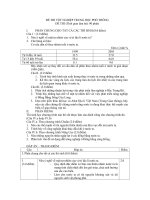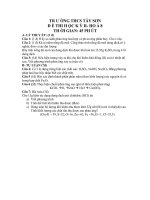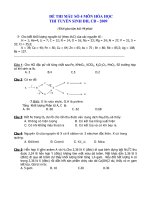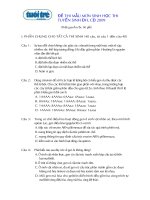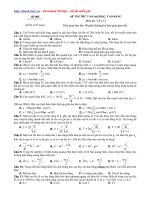TOEFL ITP - ĐỀ THI MẪU
Bạn đang xem bản rút gọn của tài liệu. Xem và tải ngay bản đầy đủ của tài liệu tại đây (257.05 KB, 41 trang )
SECTION1: PHAN NGHE:
Section 2 — Structure and Written Expression
This section is designed to measure your ability to recognize language that is
appropriate for standard written English. There are two types of questions in
this section, with special directions for each type.
Structure
Directions: Questions 1–4 are incomplete sentences. Beneath each sentence
you will see four words or phrases marked A, B, C and D. Choose the one
word or phrase that best completes the sentence. Then, on your answer sheet,
find the number of the question and fill in the space that corresponds to the
letter of the answer you have chosen.
Look at the following examples:
Example I
Geysers have often been compared to volcanoes _______ they both emit hot
liquids from below the Earth's surface.
A. due to
B. because
C. in spite of
D. regardless of
The sentence should read, "Geysers have often been compared to volcanoes
because they both emit hot liquids from below the Earth's surface."
Therefore, you should choose answer B.
Example II
During the early period of ocean navigation, ________ any need for
sophisticated instruments and techniques.
A. so that hardly
B. where there hardly was
C. hardly was
D. there was hardly
The sentence should read, "During the early period of ocean navigation,
there was hardly any need for sophisticated instruments and techniques."
Therefore, you should choose answer D.
Now begin work on the questions.
Practice Questions
1. Refrigerating meats ________ the spread of bacteria.
A. retards
B. retarding
C. to retard
D. is retarded
2. Throughout the animal kingdom, ________ bigger than the
elephant.
A. whale is only the
B. only the whale is
C. is the whale only
D. only whale is the
3. The fact ________ money orders can usually be easily cashed
has made them a popular form of payment.
A. of
B. that
C. is that
D. which is
4. The first article of the United States Constitution gives Congress
________ to pass laws.
A. the power
B. has the power
C. the power is
D. of the power
Written Expression
Directions: In questions 5–10, each sentence has four underlined words or
phrases. The four underlined parts of the sentence are marked A, B, C and
D. Identify the one underlined word or phrase that must be changed in order
for the sentence to be correct. Then, on your answer sheet, find the number
of the question and fill in the space that corresponds to the letter of the
answer you have chosen.
Look at the following examples:
The sentence should read, "Guppies are sometimes called rainbow fish
because of the males' bright colors." Therefore, you should choose answer
A.
The sentence should read, "Serving several terms in Congress, Shirley
Chisholm became an important United States politician." Therefore, you
should choose answer B.
Now begin work on the questions.
Practice Questions
Answer Key for ITP TOEFL Structure and Written Expression
1. A
2. B
3. B
4. A
5. C
6. A
7. A
8. C
9. D
10.D
Section 3 – Reading Comprehension
This section is designed to measure the ability to read and understand short
passages similar in topic and style to those found in North American
universities and colleges. Examinees read a variety of short passages on
academic subjects. Each passage is followed by a number of questions about
the material. To avoid creating an advantage to individuals in any one field
of study, sufficient context is provided so that no subject-specific familiarity
with the subject matter is required to answer the questions.
Directions: In this section you will read several passages. Each one is
followed by a number of questions about it. You are to choose the one best
answer, A, B, C or D, to each question. Then, on your answer sheet, find the
number of the question and fill in the space that corresponds to the letter of
the answer you have chosen.
Answer all questions about the information in a passage on the basis of what
is stated or implied in that passage.
Sample Passage and Questions
The railroad was not the first institution to impose
regularity on society, or to draw attention to the
importance of precise timekeeping. For as long as
Lin
e
merchants have set out their wares at daybreak and
(5) communal festivities have been celebrated, people have
been in rough agreement with their neighbors as to the
time of day. The value of this tradition is today more
apparent than ever. Were it not for public acceptance of
a single yardstick of time, social life would be unbearably
(10) chaotic: the massive daily transfers of goods, services,
and information would proceed in fits and starts; the
very fabric of modern society would begin to unravel.
Example I
What is the main idea of the passage?
A. In modern society we must make more time for our neighbors.
B. The traditions of society are timeless.
C. An accepted way of measuring time is essential for the smooth
functioning of society.
D. Society judges people by the times at which they conduct certain
activities.
The main idea of the passage is that societies need to agree about how time
is measured in order to function smoothly. Therefore, you should choose
answer C.
Example II
In line 7, the phrase "this tradition" refers to
A. the practice of starting the business day at dawn
B. friendly relations between neighbors
C. the railroad's reliance on time schedules
D. people's agreement on the measurement of time
The phrase "this tradition" refers to the preceding clause, "people have been
in rough agreement with their neighbors as to the time of day." Therefore,
you should choose answer D.
Practice Passage
The Alaska pipeline starts at the frozen edge of the
Arctic Ocean. It stretches southward across the largest
and northernmost state in the United States, ending at
Lin
e
a remote ice-free seaport village nearly 800 miles from
(5) where it begins. It is massive in size and extremely
complicated to operate.
The steel pipe crosses windswept plains and endless
miles of delicate tundra that tops the frozen ground. It
weaves through crooked canyons, climbs sheer
(10) mountains, plunges over rocky crags, makes its way
through thick forests, and passes over or under hundreds
of rivers and streams. The pipe is 4 feet in diameter, and
up to 2 million barrels (or 84 million gallons) of crude
oil can be pumped through it daily.
(15) Resting on H-shaped steel racks called "bents," long
sections of the pipeline follow a zigzag course high
above the frozen earth. Other long sections drop out of
sight beneath spongy or rocky ground and return to the
surface later on. The pattern of the pipeline's up-and-
(20) down route is determined by the often harsh demands
of the arctic and subarctic climate, the tortuous lay of
the land, and the varied compositions of soil, rock, or
permafrost (permanently frozen ground). A little more
than half of the pipeline is elevated above the ground.
(25) The remainder is buried anywhere from 3 to 12 feet,
depending largely upon the type of terrain and the
properties of the soil.
One of the largest in the world, the pipeline cost
approximately $8 billion and is by far the biggest
(30) and most expensive construction project ever
undertaken by private industry. In fact, no single
business could raise that much money, so eight major oil
companies formed a consortium in order to share
the costs. Each company controlled oil rights to
(35) particular shares of land in the oil fields and paid
into the pipeline-construction fund according to the
size of its holdings. Today, despite enormous
problems of climate, supply shortages, equipment
breakdowns, labor disagreements, treacherous
(40) terrain, a certain amount of mismanagement, and
even theft, the Alaska pipeline has been completed
and is operating.
Practice Questions
1. The passage primarily discusses the pipeline's
A. operating costs
B. employees
C. consumers
D. construction
2. The word "it" in line 5 refers to
A. pipeline
B. ocean
C. state
D. village
3. According to the passage, 84 million gallons of oil can travel
through the pipeline each
A. day
B. week
C. month
D. year
4. The phrase "Resting on" in line 15 is closest in meaning to
A. consisting of
B. supported by
C. passing under
D. protected with
5. The author mentions all of the following as important in
determining the pipeline's route EXCEPT the
A. climate
B. lay of the land itself
C. local vegetation
D. kind of soil and rock
6. The word "undertaken" in line 31 is closest in meaning to
A. removed
B. selected
C. transported
D. attempted
7. How many companies shared the costs of constructing the
pipeline?
A. three
B. four
C. eight
D. twelve
8. The word "particular" in line 35 is closest in meaning to
A. peculiar
B. specific
C. exceptional
D. equal
9. Which of the following determined what percentage of the
construction costs each member of the consortium would pay?
A. How much oil field land each company owned
B. How long each company had owned land in the oil fields
C. How many people worked for each company
D. How many oil wells were located on the company's land
10.Where in the passage does the author provide a term for an earth
covering that always remains frozen?
A. Line 4
B. Line 15
C. Line 23
D. Line 37
Answer Key for ITP TOEFL Reading Comprehension
1. D
2. A
3. A
4. B
5. C
6. D
7. C
8. B
9. A
10.C
Bai thi thu 2
Pre-TOEFL Test Section 2 – Structure and Written Expression
This section is designed to measure your ability to recognize language that is
appropriate for standard written English. There are two types of questions in
this section with special directions for each type.
Structure
Directions: Questions 1–5 are incomplete sentences. Beneath each sentence
you will see four words or phrases, marked A, B, C and D. Choose the one
word or phrase that best completes the sentence. Then, on your answer sheet,
find the number of the question and fill in the space that corresponds to the
letter you have chosen. Fill in the space so that the letter inside the oval
cannot be seen.
Look at the following example:
Mt. Hood _______ in the state of Oregon.
A. although
B. and
C. is
D. which
The correct choice is C.
Practice Questions
1. ________ most important event in San Francisco's history was
the disastrous earthquake and fire of 1906.
A. The
B. It was the
C. That the
D. There was a
2. Vegetables are an excellent source ________ vitamins.
A. of
B. has
C. where
D. that
3. Microscopes make small things appear larger than ________ .
A. really are
B. are really
C. are they really
D. they really are
4. The city of Montreal ________ over 70 square miles.
A. covers
B. that covers
C. covering
D. is covered
5. Janet Collin's struggle to make a place for herself in ballet is the
kind of life story ________ a fascinating novel might be written.
A. of
B. by
C. for whom
D. about which
Written Expression
Directions: In questions 6–10, each sentence has four underlined words or
phrases. The four underlined parts of the sentence are marked A, B, C and
D. Identify the one underlined word or phrase that must be changed in order
for the sentence to be correct. Then, on your answer sheet, find the number
of the question and fill in the space that corresponds to the letter of the
answer you have chosen.
Look at the following example:
Practice Questions
Answer Key for PRE-TOEFL Test Structure and Written Expression
1. A
2. A
3. D
4. A
5. D
6. C
7. D
8. C
9. D
10.C
Pre-TOEFL Test Section 3 – Vocabulary and Reading Comprehension
Vocabulary
Directions: Each sentence has an underlined word or phrase. Below each
sentence are four other words or phrases, marked A, B, C or D. You are to
choose the one word or phrase that best keeps the meaning of the original
sentence if it is substituted for the underlined word or phrase. Then, on your
answer sheet, find the number of the question and fill in the space that
corresponds to the letter you have chosen. Fill in the space so that the letter
inside the oval cannot be seen.
Look at the following example:
It is difficult to get young people to plan for their old age, which seems very
distant to them.
A. impossible
B. far away
C. observable
D. fearful
The correct choice is B.
Practice Questions
1. Receptors for the sense of smell are located at the top of the
nasal cavity.
A. upper end
B. inner edge
C. mouth
D. division
2. Passenger ships and aircraft are often equipped with ship-to-
shore or air-to-land radio telephones.
A. highways
B. railroads
C. planes
D. sailboats
3. Dotting the marshy expanse of the Florida Everglades are little
islands known locally as hummocks.
A. generally
B. to all
C. in that area
D. occasionally
4. It is not possible for people to remember everything that they
have thought, felt or done.
A. recall
B. appreciate
C. repeat
D. discuss
5. When preparing a diet, a person should be aware that vitamin D
acts to increase the amount of calcium absorbed by the body.
A. schedule of exercise
B. nutritional plan
C. study of longevity
D. medicinal chart
Reading Comprehension
This section is designed to measure the ability to read and understand short
passages similar in topic and style to those found in North American
universities and colleges. Examinees read a variety of short passages on
academic subjects. Each passage is followed by a number of questions about
the material. To avoid creating an advantage to individuals in any one field
of study, sufficient context is provided so that no subject-specific familiarity
with the subject matter is required to answer the questions.
Directions: In this section you will read several passages. Each one is
followed by several questions about it. You are to choose the one best
answer, A, B, C or D, to each question. Then, on your answer sheet, find the
number of the question and fill in the space that corresponds to the letter of
the answer you have chosen.
Answer all questions following the passage on the basis of what is stated or
implied in the passage.
Sample Passage and Questions
A new atomic clock being developed for navigation
satellites will perform better than previous devices.
The
clock, which incorporates a hydrogen maser, will use a
Lin
e
new microwave cavity design to provide a compact and
(5) lightweight package, and new electronic techniques to
maintain long-term stability. The clock can provide
precise navigation information because it is stable to
one second in three million years. The differences in
the time when signals from four satellites arrive at one
(10) location can be used to calculate that position to within
a few yards.
Look at the following example:
From the passage, it can be inferred that which of the following
characteristics of the clock mentioned will be most impressive?
A. Its compact size
B. Its weight
C. Its accuracy
D. Its ability to measure distance
The correct choice is C.
6. It can be inferred from the passage that the new clock will be
A. long-lasting
B. harmful to humans
C. produced in great numbers
D. very attractive looking
7. According to the passage, signals from how many satellites will
be used to calculate a position?
A. 1
B. 2<
C. 3<
D. 4
8. What is the primary purpose of the passage?
A. To teach a lesson
B. To sell a product
C. To support a theory
D. To provide information
Answer Key for PRE-TOEFL Test Vocabulary and Reading
Comprehension
1. A
2. C
3. C
4. A
5. B
6. A
7. D
8. D
Listening Comprehension Practice Questions
— Section 1
The Listening Comprehension section tests your ability to understand both
short and long conversations in English. The section contains recorded
material that is similar to what you might hear if you were with a group of
students at an English-speaking college or university. The language includes
• vocabulary and idiomatic expressions common to spoken
English
• special grammatical constructions used in speech
Before completing these practice questions, print out an answer sheet so that
you can become familiar with the format.
Directions and Practice Questions
Directions and examples of the types of questions you will find in the
Listening Comprehension section of the TOEFL® test are below.
There are three parts to this section, with special directions for each part.
Answer all questions based on what is stated or implied by the speakers you
hear.
Do not
• take notes or write in your test book at any time
• turn the pages until you are told to do so.
Part A
Directions: In Part A, you will hear short conversations between two
people. After each conversation, you will hear a question about the
conversation. The conversations and questions will not be repeated. After
you hear a question, read the four possible answers in your test book and
choose the best answer. Then, on your answer sheet, find the number of the
question and fill in the space that corresponds to the letter of the answer you
have chosen.
Here is an example.
On the recording, you will hear:
(woman)
I don't like this painting very
much.
(man) Neither do I.
(narrator) What does the man mean?
In your test book, you will read:
A. He doesn't like the painting either.
B. He doesn't know how to paint.
C. He doesn't have any paintings.
D. He doesn't know what to do.
You learn from the conversation that neither the man nor the woman likes
the painting. The best answer to the question, "What does the man mean?" is
A, "He doesn't like the painting either." Therefore, the correct choice is A.
PRACTICE QUESTIONS
1. You will
hear:
(man) Shall I lock up the computer lab now before I go home?
(woman)
Don't bother. I'm not leaving for a while, I can check it on
my way out.
(narrator) What will the woman probably do?
You will
read:
A. Lock the computer lab later.
B. Leave with the man.
C. Buy a new lock for the computer lab.
D. Show the man where the lab is.
2. You will
hear:
(man) Do you mind if I turn the television off?
(woman)
Well, I'm in the middle of watching a
program.
(narrator) What does the woman imply?
You will A. The man should watch the program too.
read:
B. The man should leave the television on.
C. The program will be over soon.
D. She'll watch television later.
3. You will
hear:
(woman)
I heard the math requirements for graduation are being
changed.
(man) Yes. And I may be short one course.
(narrator) What does the man mean?
You will
read:
A. He isn't sure what course to take.
B. The math course is too short.
C. He may not meet the graduation
requirements.
D. The graduation date has been changed.
Part B
Directions: In this part of the test you will hear longer conversations. After
each conversation you will hear several questions. The conversations and
questions will not be repeated.
After you hear a question, read the four possible answers in your test book
and choose the best answer. Then, on your answer sheet, find the number of
the question and fill in the space that corresponds to the letter of the answer
you have chosen.
Remember, you are not allowed to take notes or write in your test book.
SAMPLE CONVERSATION AND PRACTICE QUESTIONS
(narrator)
Questions 4 through 7. Listen to a conversation about a
trip.
(man) Are you ready for "The Big Apple"?
(woman) Excuse me?
(man)
You know, New York City. You are going to New York with
us, aren't you? I wanted to show everybody around my old
neighborhood.
(woman)
Oh sure! I wouldn't miss it especially when the tour guide
is a native New Yorker.
(man)
I thought we could start at the Museum of Modern Art.
Right now there's an exhibit on twentieth-century
American painters.
(woman)
Fine with me but what were you saying about a big
apple?
(man)
"The Big Apple." It's a nickname for New York. I think I
heard once that it started with jazz musicians in the 20's.
(woman) Oh.
(man)
Whenever they played a concert in a city, they called that
city an "apple." In those days, New York was the biggest
city in the country, so they called it "The Big Apple."
(woman)
Hey, I have an idea! Let's go to a jazz club while we're
there.
(man) Sounds good.
Questions:
4. You will
hear:
(narrator)
What is the man planning to
see?
You will
read:
A. An art exhibit.
B. A Broadway play.
C. A modern dance production.
D. An opera.
5. You will
hear:
(narrator)
What can be inferred about the
man?
You will
read:
A. He is a jazz musician.
B. He wants to join the woman's club.
C. He is in his twenties.
D. He was born in New York.
6. You will
hear:
(narrator)
What does the word "Apple" in the phrase "The Big Apple"
refer to?
You will
read:
A. An instrument.
B. A city.
C. A theater.
D. A concert.
7. You will
hear:
(narrator)
Who gave New York its
nickname?
You will
read:
A. Painters.
B. Tour guides.
C. Musicians.
D. Grocers.
Part C
Directions: In this part of the test you will hear several talks. After each
talk, you will hear some questions. The talks and questions will not be
repeated.
After you hear a question, read the four possible answers in your test book
and choose the best answer. Then, on your answer sheet, find the number of
the question and fill in the space that corresponds to the letter of the answer
you have chosen.
Here is an example.
On the recording, you will hear:
(narrator)
Listen to an instructor talk to his class about a television
program.
(man) I'd like to tell you about an interesting TV program that'll
be shown this coming Thursday. It'll be on from 9 to 10
p.m. on Channel 4. It's part of a series called "Mysteries of
Human Biology." The subject of the program is the human
brain — how it functions and how it can malfunction.
Topics that will be covered are dreams, memory, and
depression. These topics are illustrated with outstanding
computer animation that makes the explanations easy to
follow. Make an effort to see this show. Since we've been
studying the nervous system in class, I know you'll find it
very helpful.
Here is an example.
You will
hear:
(narrator)
What is the main purpose of the
program?
In your test book, you will read:
A. To demonstrate the latest use of computer graphics.
B. To discuss the possibility of an economic depression.
C. To explain the workings of the brain.
D. To dramatize a famous mystery story.
The best answer to the question, "What is the main purpose of the program?"
is C, "To explain the workings of the brain." Therefore, the correct choice is
C.
Here is another example.
You will
hear:
(narrator)
Why does the speaker recommend watching the
program?
In your test book, you will read:
A. It is required of all science majors.
B. It will never be shown again.
C. It can help viewers improve their memory skills.
D. It will help with course work.
The best answer to the question, "Why does the speaker recommend
watching the program?" is D, "It will help with course work." Therefore, the
correct choice is D.
Remember, you are not allowed to take notes or write in your test book.
PRACTICE TALK AND PRACTICE QUESTIONS
(narrator)
Questions 8 through 10. Listen to a talk about animal
behavior.
(woman) Today's discussion is about a common animal reaction —
the yawn. The dictionary defines a yawn as "an
involuntary reaction to fatigue or boredom." That's
certainly true for human yawns, but not necessarily for
animal yawns. The same action can have quite different
meanings in different species.
For example, some animals yawn to intimidate intruders
on their territory. Fish and lizards are examples of this.
Hippos use yawns when they want to settle a quarrel.
Observers have seen two hippos yawn at each other for as
long as two hours before they stop quarreling.
As for social animals like baboons or lions — they yawn to
establish the pecking order within social groups, and lions
often yawn to calm social tensions. Sometimes these
animals yawn for a strictly physiological reason — that is,
to increase oxygen levels. And curiously enough, when
they yawn for a physical reason like that, they do what
humans do — they try to stifle the yawn by looking away or
by covering their mouths.
Questions:
8. You will
hear:
(narrator)
What is the speaker's main
point?
You will
read:
A. Animals yawn for a number of reasons.
B. Yawning results only from fatigue or boredom.
C. Human yawns are the same as those of other
animals.
D. Only social animals yawn.
9. You will
hear:
(narrator)
According to the speaker, when are hippos likely to
yawn?
You will
read:
A. When they are swimming.
B. When they are quarreling.
C. When they are socializing.


